Intel Core i7-11700K Review: Blasting Off with Rocket Lake
by Dr. Ian Cutress on March 5, 2021 4:30 PM EST- Posted in
- CPUs
- Intel
- 14nm
- Xe-LP
- Rocket Lake
- Cypress Cove
- i7-11700K
Gaming Tests: F1 2019
The F1 racing games from Codemasters have been popular benchmarks in the tech community, mostly for ease-of-use and that they seem to take advantage of any area of a machine that might be better than another. The 2019 edition of the game features all 21 circuits on the calendar for that year, and includes a range of retro models and DLC focusing on the careers of Alain Prost and Ayrton Senna. Built on the EGO Engine 3.0, the game has been criticized similarly to most annual sports games, by not offering enough season-to-season graphical fidelity updates to make investing in the latest title worth it, however the 2019 edition revamps up the Career mode, with features such as in-season driver swaps coming into the mix. The quality of the graphics this time around is also superb, even at 4K low or 1080p Ultra.
For our test, we put Alex Albon in the Red Bull in position #20, for a dry two-lap race around Austin. We test at the following settings:
- 768p Ultra Low, 1440p Ultra Low, 4K Ultra Low, 1080p Ultra
In terms of automation, F1 2019 has an in-game benchmark that can be called from the command line, and the output file has frame times. We repeat each resolution setting for a minimum of 10 minutes, taking the averages and percentiles.
| AnandTech | Low Resolution Low Quality |
Medium Resolution Low Quality |
High Resolution Low Quality |
Medium Resolution Max Quality |
| Average FPS |  |
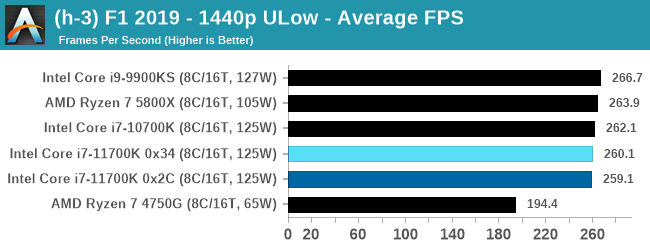 |
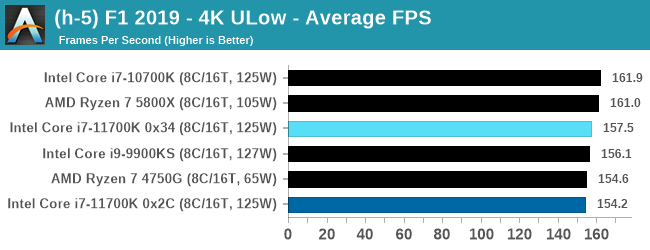 |
 |
| 95th Percentile | 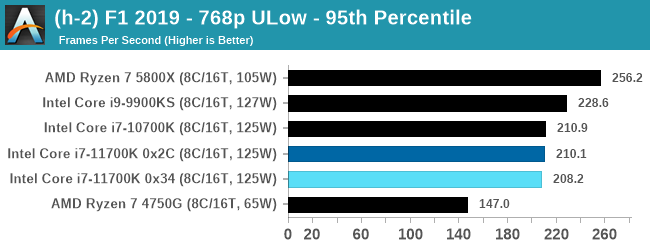 |
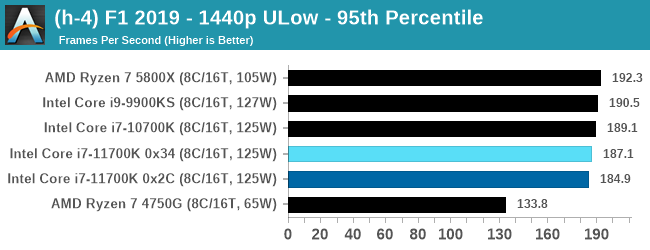 |
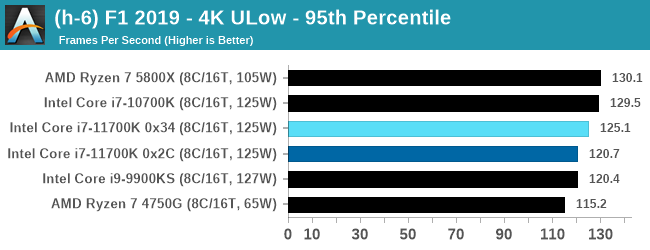 |
 |
The Ego engine is usually a good bet where cores, IPC, and frequency matters. Despite this, the 11700K isn't showing much of a generational improvement.
All of our benchmark results can also be found in our benchmark engine, Bench.












541 Comments
View All Comments
terroradagio - Friday, March 5, 2021 - link
I'd be saying this if they did with an AMD part too. This is something I would expect from someone unknown guy doing reviews, not Anandtech. Extremely disappointing they are going for the click bait.Otritus - Saturday, March 6, 2021 - link
We used to have performance previews all the time back in the day to let people have an idea of what is coming and if it is worth it to wait for the next generation. Consider this to be a performance preview, meaning final performance will be higher. In general workloads rocket lake is 10-15 % faster while being reasonable with power. In gaming it's trash, but that could be a consequence of the non-finalized nature of the product.By the time someone can reasonably buy this product it will be April/May. If I need a pc now, the performance uplift isn't that high to make me have buyers remorse. If I can wait, I can get a comet lake chip at probably a great discount, or if rocket lake's gaming is fixed, get that instead.
Performance previews like this are excellent journalism because the public is informed of things that are otherwise concealed. My only gripe with the article is calling it a "review" instead of "early review" or "preview" because someone may stumble on this article and mistakenly believe this is how the product will be shipped.
sonny73n - Saturday, March 6, 2021 - link
This is a REVIEW! Not early review or preview or any excuse you're making. You've lost touch with reality if you hope for a higher performance on official release date. If Intel haven't released these CPUs (before their announced release date), no way in hell Anandtech or anyone would be able to purchase them.Spunjji - Saturday, March 6, 2021 - link
I'm amused by how many people have stumbled upon this and are mistakenly assuming that performance will be significantly better when it's shipped. This was a CPU bought at retail running on a retail motherboard. If they do noticeably improve performance (and it's a big if) consumers will have to install updates themselves to get it.Makste - Saturday, March 6, 2021 - link
This is not an engineering sample. If hundreds were being sold by a retailer then that is what Intel was intending to sell to its clients. If you are not satisfied with the performance don't blame it on Anandtechshady28 - Saturday, March 6, 2021 - link
This is labelled review, not performance preview.Cutress is officially a hack now. I'll wait for real reviews on systems that officially and properly support the chip.
schujj07 - Saturday, March 6, 2021 - link
It was a review. This was a retail CPU running on a motherboard with a BIOS that supports RKL. Just because RKL doesn't look good isn't surprising.shady28 - Sunday, March 7, 2021 - link
On a ++BETA++ BIOS.schujj07 - Monday, March 8, 2021 - link
Unless you have something like the X570 and Zen2 being released at the same time, quite often it is a Beta BIOS that gives initial support for new chips. Eventually with further validation that Beta BIOS becomes official. Perfect example of this is in October 2019 I was installing vSphere 6.7 onto some servers. With the initial BIOS release I was getting the Purple Screen of Death. The only BIOS that was available was a Beta BIOS and on that vSphere installed just fine. Push forward a month later and the official supported BIOS by VMware for that server was the Beta BIOS for vSphere 6.7. It took another 6 months before a non-beta BIOS was available for that server as well. Hence just because it is Beta doesn't mean it is bad. Things in Beta testing generally have full features and performance just hasn't been validated long enough to become the official release.Qasar - Sunday, March 7, 2021 - link
like that will change much, if anything shady28.